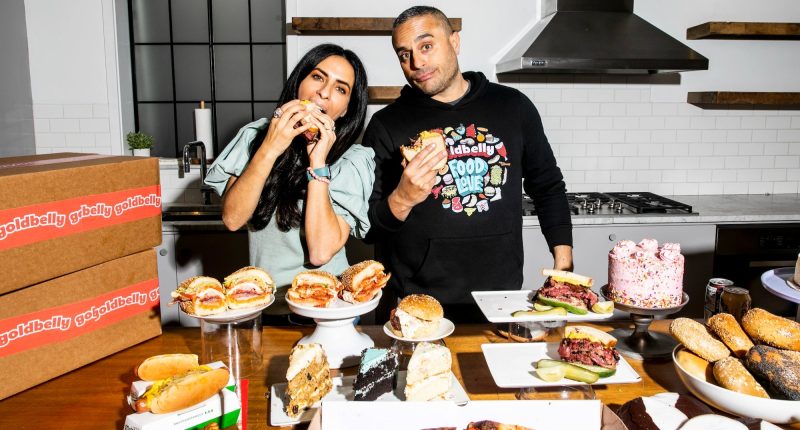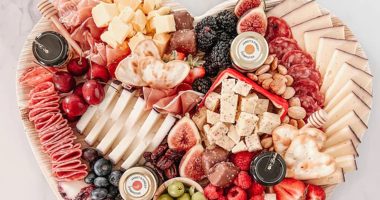Goldbelly co-founder and chief product officer Vanessa Ariel grew up in Venezuela and moved to the U.S. when she was 18, so she’s well-acquainted with “food nostalgia” — the hankering for a favorite dish that can’t be found where you are. In Venezuela, “Our no. 1 comfort food is an arepa,” Ariel tells Entrepreneur. “An arepa is so comforting that you eat it for breakfast, lunch and dinner. You can stuff it with meat, you can stuff it with veggies, you can stuff it with cheese, it doesn’t matter. You can eat this at 3 a.m. — you can eat it at 3 p.m. And it is incredible.”
Her husband and co-founder, Joe Ariel, was familiar with food nostalgia too, in a different way. Born and raised in New York, he attended college in Nashville, and when he returned to his home state, he couldn’t find the Southern cuisine he’d come to love. “We were dating at the time,” Ariel recalls, “and he would always talk about these foods and how he would pay anything to get these foods here so that I could try them. So it went from this beautiful, What if we could do this? to making it into a reality.”
“It felt like a very ambitious idea,” Ariel adds, “but also like the future.” The duo was confident a platform of its kind would exist one day — so why not be the ones to make it happen?
Back then, in 2012, Ariel didn’t necessarily make the connection between her and Joe’s experiences of missing their favorite foods. But more than a decade after they and co-founders Joel Gillman and Trevor Stow began building the business that would grow into a food-delivery platform with nationwide reach and millions of customers, she acknowledges the parallel — and sometimes finds it hard to believe that their big dream turned into an even bigger success. To date, Goldbelly has raised $133 million and boasts more than 1,000 restaurants on its site.
Related: 15 Strategies for Quickly Expanding Your Business | Entrepreneur
One restaurant on the platform that hits particularly close to home is Doggi’s Arepa Bar based in Miami, Florida. “There’s never a time that I have an arepa that I don’t cry,” Ariel says. “One hundred percent of the time, I cry. It reminds me of my home, of my parents, of my grandmother who made me arepas every single day. And so, for the first time, I was able to experience this food nostalgia just through one of my own foods that I grew up eating, which I never had the opportunity to do until now.”
It’s Hispanic Heritage Month (September 15-October 15), and Goldbelly is celebrating with a collection featuring acclaimed Hispanic chefs and food makers “shipping unforgettable restaurant experiences to your door” — now and year around. Food Network star Aarón Sánchez of New Orleans-based Johnny Sanchez, Chef Arnaldo Richards of Houston-based Picos Mexican Restaurant and Fany Gerson of Brooklyn-based La Newyorkina are among some of those highlighted.
“I got a lot of inspiration from the fashion industry, which photographs items in such a beautiful, aspirational way.”
Goldbelly’s road to success wasn’t always smooth, but the business got an early break when it was accepted into Y Combinator in 2013. Goldbelly had already gained some traction, “but Y Combinator [created a] support system for us,” Ariel says. “It made it feel less lonely to be entrepreneurs. We were paired with other people that were building companies in different industries that were facing similar challenges. So we got to learn from conversations that we were having with our peers.”
The funding from Y Combinator allowed Ariel to quit her job and work on the startup full-time. With a background in UI/UX design, branding and ecommerce, she had a clear vision for a marketplace where people could order the best foods to be shipped nationwide. But she also recognized a significant problem from the start: To work, the platform “needed to be a visual experience” — yet most restaurants didn’t have photography fit for Goldbelly’s purposes.
Related: 7 Ways to Improve Online Engagement With Visual Content
“Most restaurants had photos of their dishes that just came out of the oven, that were styled at their restaurants, that had all of this dishware, or stuff that was not really polished or aspirational,” Ariel explains. “But I got a lot of inspiration from the fashion industry, which photographs items in such a beautiful, aspirational way. They show you how to wear it. They show you how to include it in your daily life.”
 Image Credit: Courtesy of Goldbelly. Testing photography in the early days.
Image Credit: Courtesy of Goldbelly. Testing photography in the early days.
It took a couple of years to strike the perfect balance and “tell the right story,” which gave people an accurate picture of what they’d receive, didn’t make Goldbelly look like a recipe site and kept everything aspirational. At the time, it was challenging to depict assembly (but not cooking), though the practice is common within the growing meal-kit industry today, Ariel says.
“We weren’t the most convenient. We weren’t the cheapest. But what we are and have always been is the best.”
When the co-founders returned to New York, another hurdle awaited them: pitching investors. With the vast array of cuisines available in the city, it was difficult for some of them to see the value in Goldbelly’s offering. The company doesn’t limit food options based on location and reduces the friction and complexity of ordering out of state.
“Our sweet spot is focusing on the foods people love the most,” Ariel says. With just a few clicks, customers can order pizza from Lou Malnati’s in Chicago or smoked brisket from Terry Black’s Barbecue in Austin and find them at their doorstep courtesy of FedEx or UPS in a matter of days. But the service isn’t inexpensive either; the Terry Black’s offering comes with four to five pounds of brisket and costs about $250.
 Image Credit: Courtesy of Goldbelly. Bartolini’s Pizza.
Image Credit: Courtesy of Goldbelly. Bartolini’s Pizza.
Related: Are You Reducing Friction For Your Sales Team? If Not, Here’s Why.
“[New York investors] thought about it as a commodity business,” Ariel explains. “They were thinking about food delivery, like how to get [it] to you. The nearest, fastest [delivery] to your office or home. And we were so the opposite of that: We weren’t the most convenient. We weren’t the cheapest. But what we are and have always been is the best.”
Goldbelly’s growth over the years has proven its model, but perhaps the greatest testament to its necessity and success came during the pandemic when customers craved the comfort their favorite foods could provide and restaurants struggled to maintain revenue. At the time, Goldbelly “was bursting at the seams on the customer side and the merchant side,” Ariel recalls. The company gained a million new customers in 2020 and saw annual sales jump 300% compared to 2019.
“We want to help you discover a dish that you never knew existed, through something else that you already love and that you’ve been in your entire life.”
Next up? Goldbelly plans to use AI to recommend foods and help people find new favorites, taking inspiration from music streaming services like Spotify.
“Music and food are very similar in the sense that it’s through food and music you can relive a moment, celebrate something, that you can [create] a mood, show someone affection,” Ariel explains. “Music streaming services have [broken open] the discovery experience. That is something that can be directly applied to food. So we are experimenting with AI to help people find foods from their past. We want to help you discover a dish you never knew existed through something else you already love and have your entire life.”
Related: JPMorgan’s Jamie Dimon Says AI Leads to 3.5-Day Work Week
 Image Credit: Courtesy of Goldbelly.
Image Credit: Courtesy of Goldbelly.
And once people reconnect with foods from their past, Goldbelly’s there to make them easy to enjoy. Just consider Ariel’s beloved arepas: They’re delicious, but putting them together can be “intimidating,” she says — and it’s “the combination of ingredients that makes an arepa special.”
“The fact that I can go to Goldbelly and get a kit that gives me the exact kind of meat that is shredded the way it needs to be, that is seasoned the way it needs to be, the exact kind of cheese, the exact kind of beans that my grandmother [made], the fact that I can get this in a kit, I cry every single time,” Ariel says. “And I know this kit wouldn’t exist had we not come up with this company.”








